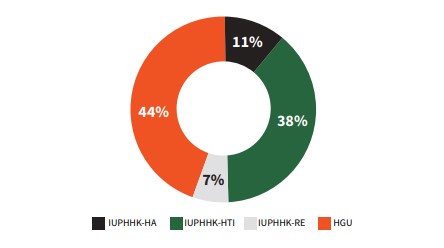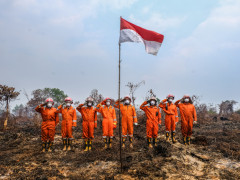Chapter 1: Report After Three Years on The Food Estate Project in Central Kalimantan
By Oriz Anugerah Putra, Desti Ayunda (WRI Indonesia), Agiel Prakoso, Iola AbasPiecing Together the Puzzle Pieces of Peat Ecosystem Protection in Concession Areas
Massive land and forest fires recurred in peat areas throughout 2019, despite restoration activities and strengthened commitment for peat protection. Peatland fires have also been identified in a number of concession areas that should have carried out the restoration mandate since the 2015 major forest fires.
The results of Pantau Gambut’s analysis of the peat area burned between 2015–2019 showed that of the total 1.4 million hectares of peat burned, 70% or around 1.02 million hectares were inside concession areas: 580,764.5 hectares under the Land Use Rights (HGU); 168,988.1 hectares under the Business Permit for Utilization of Timber Forest Products-Industrial Plantation Forest (IUPHHK-HTI); 83,575.6 hectares under the Business Permit for Utilization of Timber Forest Products-Ecosystem Restoration (IUPHHK-RE); and 187,047.9 hectares under the Business Permit for the Utilization of Natural Forest Products (IUPHHK-HA).
The use of peatlands for extractive industrial plants has been done for a long time. Of the total area of 13.4 million peatlands in Indonesia, 5.2 million hectares are areas that have been granted permits to business actors (concessions). However, many of these concessions are still using the land in an unsustainable way, so the impact of poor management has resulted in fires that still occur frequently in the concession area to this day.
In fact, there are many regulations governing the protection of peat ecosystems that must be carried out by permit holders/land owners. For instance, the Government of Indonesia issued various technical regulations related to the protection and management of peat ecosystems such as Presidential Regulation No. 71 of 2014 which was later revised into Presidential Regulation No. 57 of 2016. The regulation describes guidelines for sustainable peat management to law enforcement for perpetrators of peatland destruction.
Pantau Gambut conducts research with the community to see how far the company has implemented existing regulations related to peatland protection. From the results of observations and research conducted, Pantau Gambut noted two important things:
First, most companies have not implemented the regulation to restore the peat ecosystem.
Second, land clearing and the use of protected Peat Ecosystem Functions (FEG) for extractive plants remain active.
Read the complete Peat Monitoring Report on “Piecing Together the Puzzle Pieces of Peat Ecosystem Protection in Concession Areas”.




